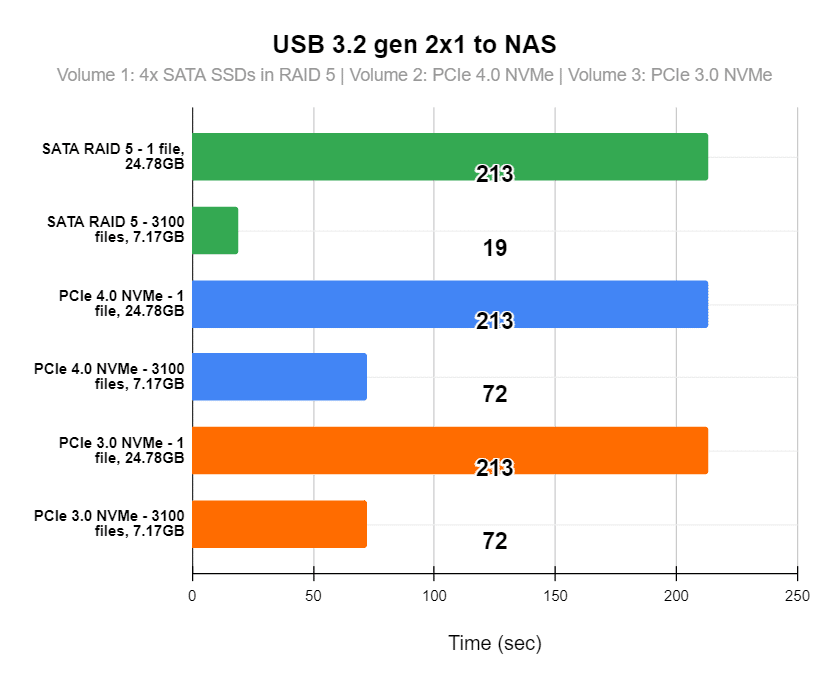Performance
Synthetic Benchmarks
ATTO
The read and write speeds of the SATA RAID 5 and the NVMe’s are very similar, but the PCIe 4.0 NVMe has the edge. As you can see, it’s the only one out of the three that can maximize both read and write speeds. The other two struggled a bit with the write speeds but were very close.
Crystal Disk Mark
In CDM, the differences are also small. The RND4K Q32T1 performance of the PCIe 4.0 was again a bit better, while the rest of the results did not have any significant differences to each other. During the large sequential read and write speeds, the 5Gbit connection to the client was saturated.
External File Transfers
Transferring the large movie file from an external USB storage device took the same time, regardless of the target volume. On the other hand, transferring many smaller files was significantly faster when targeting the RAID 5 volume.
When transferring a large movie file, the speed is likely limited by the USB storage device’s read speed, like on this occasion, or the USB interface bandwidth. RAID 5 and PCIe NVMe volumes can handle much higher sequential write speeds than the USB can deliver, so they are not the bottleneck.
RAID 5 involves striping data across multiple drives with parity. For small files, this striping allows the RAID array to distribute the workload across multiple drives, enabling better parallel processing. A single PCIe NVMe drive handles all the data on its own. While it has lower latency and higher peak performance, it doesn’t benefit from the parallelism RAID 5 offers for small files.
Internal File Transfers
The transfer speeds for both transfer types to both tar
Observing the transfers starting from the PCIe 4.0 NVMe and the PCIe 3.0 NVMe in tandem, it’s a bit clearer where the bottlenecks lie. For the transfers starting from the PCIe 4.0 NVMe, the limit seems to be the maximum write speed of the target volumes, which coincidentally are very similar. The higher write speeds observed from PCIe 3.0 to PCIe 4.0 are due to the combination of the higher write throughput of the PCIe 4.0 NVMe drive and the good read speed of the PCIe 3.0 drive.
Additional Performance Metrics
Power Consumption
The Lockerstor 4 Gen 3 is designed to be energy-efficient, which is one of the reasons that led to a Ryzen CPU. During normal operation, it draws between 27W and 34W, which is quite good, especially considering the extra power on tap, with its four cores and eight threads of Ryzen Zen 3+ architecture. Keep in mind that in our testing, we are using SSD SATA drives, which skews the power consumption to lower values. Nonetheless, seeing such low power consumption in low-load situations from such a fast CPU is impressive. In sleep mode, the power consumption is again very acceptable, remaining around 17W to 19W.
An external 90W Delta Electronics power supply provides this power. An external power supply might seem negative since it adds yet another external component, but it means you can easily replace it in case of failure.
Heat Management
Maintaining optimal temperatures is essential for the performance and longevity of any NAS. This one features a 120mm system fan alongside a durable metal chassis that promotes efficient airflow, ensuring that the CPU and drives remain cool, even during intensive tasks. There are cooling vents on the side where the mainboard sits, on the top, on the front of the drive trays, and obviously around the back, where the fan sits.
The NVMe drives remain very cool, reaching a maximum of 54 deg. C during our heaviest testing, in 23 deg. C of ambient temperature. The vents on the top allow the hot air to be easily extracted, aiding in their cooling.
The Ryzen CPU has a beefy cooler with a long copper tube and aluminum fins. This contraption extends from the mainboard to the rear of the chassis, where the fan is. Subsequently, the CPU gets cooled by the air pulled through the side vent over the mainboard and by the air coming from the front of the chassis.
The external power supply also minimizes internal heat production, enhancing thermal management.
Noise Levels
AS6804T, belonging to the Lockerstor lineup, is focused more on performance and build quality rather than silent operation. However, no sacrifices have been made in this case, as it was impressively silent despite the primarily metal construction. Having it side by side with the AS5404T, which is mainly made of plastic, the difference in noise was negligible. This is one of the advantages of using SSD SATA drives. The fan, while spinning all the time, operates silently.
RAID 5 initialization time
Boot, Reboot & Shut Down
| Time to… | |
|---|---|
| Boot | 120s |
| Reboot | 135s |
| Shut Down | 44s |












